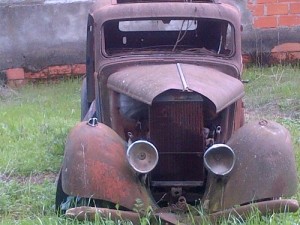You know you’re in the depths of the campagne when you start spotting decaying cars, vans and buses rotting away next to old farmhouses that would be worth a fortune if they were within an hour of an internet connection that allowed skyping. This is true in the UK as well as France. I used to visit Nenthead in Northumberland and most homes had a redundant coach gathering moss somewhere nearby. Mind you, the only residents I ever met resembled the bald bloke from “The Hills Have Eyes” so I’m not sure they are truly or fully representative of all rural communities.
Still, there is certainly something in the DNA of the hardcore country dweller that makes them want to hang on to ancient vehicles no matter how ravaged by time they might be. In some cases this is understandable. A couple of years ago I very nearly acquired a Porsche Speedster that had been quietly slipping into its dotage in a barn for a few decades. You don’t have to be a cannibalistic mutant to find yourself unable to part with the car that James Dean died in. Hanging on to it in the belief that you’ll get it back on the road one day makes perfect sense. Refusing to let go of a severely crash damaged Renault Twingo doesn’t.
I can only think of two possible explanations for this behaviour. The first is that these people genuinely feel that they are somehow landscaping their gardens. You wouldn’t see it on Gardener’s World but when my friend glimpsed the front grille of a 1934 Citroen at the centre of an impenetrable bramble patch it added some glamour and excitement to an overgrown area that otherwise held little interest. The bloke near us who keeps his chickens in an extensive collection of dead Renault vans won’t be appearing at The Chelsea Flower Show this year but his fowl are dry and his plot has a distinctive look that wooden huts could never achieve. Maybe some people just prefer dirty oil features to water features.
The other, specifically French reason, is a splendidly stubborn approach to prices. Ever since moving here nearly six years ago I’ve regularly driven past a trailer with a hand painted AV sign attached. When I first saw it next to the entrance to someone’s drive I stopped and looked. The dirty green emulsion that had been slapped on did nothing to hide the rotten wood and any metal parts were heavily rusted. The tyres were perished and the wheels had sunk into the ground. I honestly thought that any attempt to move it from its resting place would cause immediate and complete disintegration. The owner was after 800 euros for it!
Last December I noticed a change. Nature was even further into the process of reclaiming the trailer but old AV sign had been replaced with a piece of white formica board. The price remained the same.
Maybe this indefatigable optimism when it comes to prices explains the widespread hoarding of useless vehicles. If, as seems to be the case, any car deemed roadworthy by the somewhat liberal Controle Technique testing regime is immediately worth €2,000, regardless of condition or accumulated miles, then any automobile, even one that isn’t mobile, must be worth half that. This impeccable financial logic might fly in the face of the fact that nobody will ever actually pay the asking price but why else would so many people want to have their own miniature junkyards?
